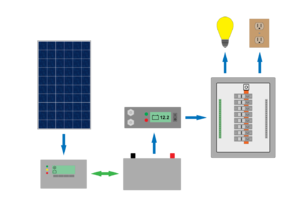Difference between revisions of "Low voltage disconnect"
| Line 1: | Line 1: | ||
[[Category:Loads]] | [[Category:Loads]] | ||
| − | [[File:Lvdconnections201108.png|thumb|right| | + | [[File:Lvdconnections201108.png|thumb|right|A stand-alone low voltage disconnect that is between the battery bank and DC loads.]] |
A load voltage disconnect (LVD) is a key component of a PV system that disconnects loads from the battery bank if the battery bank drops below a certain voltage. This is important as it protects the batteries from over-discharge which can greatly reduce their [[Energy storage#Cycle life|cycle life]]. A low voltage disconnect is often integrated into charge controllers and inverters, but also may be a stand-alone component when larger DC loads, like water pumps or refrigerators, that need to be connected directly to the battery bank are used. If the LVD is integrated into a charge controller or inverter, it is important to check whether it is possible to program a higher or lower voltage that may better suit the needs of the system. The LVD voltage on these devices is often set very low at around 10%-20% [[Energy storage#State of charge|state of charge]]. It is important to note that voltage of a battery bank can drop rapidly if it is put under significant load and could cause a LVD with too high of a value to disconnect the loads when it is not desirable. | A load voltage disconnect (LVD) is a key component of a PV system that disconnects loads from the battery bank if the battery bank drops below a certain voltage. This is important as it protects the batteries from over-discharge which can greatly reduce their [[Energy storage#Cycle life|cycle life]]. A low voltage disconnect is often integrated into charge controllers and inverters, but also may be a stand-alone component when larger DC loads, like water pumps or refrigerators, that need to be connected directly to the battery bank are used. If the LVD is integrated into a charge controller or inverter, it is important to check whether it is possible to program a higher or lower voltage that may better suit the needs of the system. The LVD voltage on these devices is often set very low at around 10%-20% [[Energy storage#State of charge|state of charge]]. It is important to note that voltage of a battery bank can drop rapidly if it is put under significant load and could cause a LVD with too high of a value to disconnect the loads when it is not desirable. | ||
Revision as of 11:56, 13 November 2020
A load voltage disconnect (LVD) is a key component of a PV system that disconnects loads from the battery bank if the battery bank drops below a certain voltage. This is important as it protects the batteries from over-discharge which can greatly reduce their cycle life. A low voltage disconnect is often integrated into charge controllers and inverters, but also may be a stand-alone component when larger DC loads, like water pumps or refrigerators, that need to be connected directly to the battery bank are used. If the LVD is integrated into a charge controller or inverter, it is important to check whether it is possible to program a higher or lower voltage that may better suit the needs of the system. The LVD voltage on these devices is often set very low at around 10%-20% state of charge. It is important to note that voltage of a battery bank can drop rapidly if it is put under significant load and could cause a LVD with too high of a value to disconnect the loads when it is not desirable.
